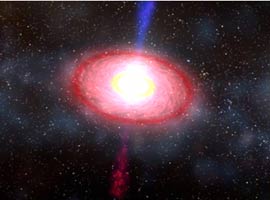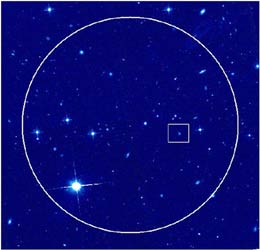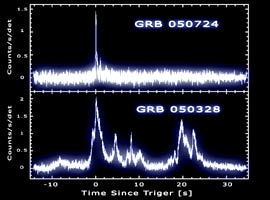
Artist Dana Berry depicts the gamma-ray burst (GRB) that occurs when a black hole swallows a neutron star. Click on the image above to view an animation of a neutron star falling into a black hole, triggering a short GRB (it might take a minute or two for the movie to load onto your computer).
Courtesy NASA / GSFC / Dana Berry.
Compelling new evidence strongly supports the prevailing theory that most short gamma-ray bursts (those lasting 2 seconds or less) are triggered when two compact objects in a binary system spiral and then smash into each other in a cosmic cataclysm. In some cases, two neutron stars collide and form a black hole. In others, a black hole swallows a neutron star. Either way, material is ejected in two oppositely directed high-speed jets along the black hole's rotational axis, creating the GRB.
The latest evidence for the merger theory comes from five short GRBs observed since May 2005. Four of the five, occurring on May 9th, July 24th, August 13th, and September 6th, were caught by NASA's Swift satellite. A short GRB on July 9th was detected by NASA's HETE-2 (High Energy Transient Explorer-2) satellite. Both Swift and HETE-2 can pinpoint the location of bursts quickly, allowing ground- and space-based telescopes to study the fading afterglows. The afterglows, in turn, are the keys that are helping astronomers unlock the short-GRB mystery. HETE-2's detection of the July 9th burst was particularly important since it led to the first visible-light detection of a short GRB afterglow, which enabled astronomers to localize the burst in its host galaxy to very high precision.

The Hubble Space Telescope caught the afterglow (inside the box) of the July 9th short GRB. The burst itself was detected by NASA's HETE-2 satellite. This was the first time that astronomers saw an optical afterglow from a short GRB.
Courtesy Derek Fox / NASA / STScI.
All five of the short bursts exploded in relatively nearby galaxies and had similar peak luminosities. The short bursts are generally much closer and about 1,000 times less energetic than the more common long GRBs, which come from the explosions of massive stars. The energy range for the short bursts matches what theorists expect for merging compact objects. Despite the fact that the five short bursts are much less powerful than the longer variety, they still pack an extraordinary punch, blazing with the energy of more than a billion Suns during their moment of peak output. This is too much energy for giant flares from magnetars (highly magnetized neutron stars), which means these events can only account for a small fraction of short GRBs.
Follow-up observations of all five short bursts have failed to uncover any hint of supernova-like activity, essentially ruling out the possibility that these events were caused by solitary exploding stars. Hubble Space Telescope afterglow observations of the July 9th burst are particularly significant. Since Hubble could see its afterglow, a supernova could not have been obscured by dust, and Hubble looked 100 times deeper than was necessary to reveal a supernova. "You can't hide the supernova for the July 9th burst," says Derek B. Fox (Pennsylvania State University). "But whenever we observe a long burst in a nearby galaxy where we can detect a supernova, we do detect a supernova."

The Hubble Space Telescope monitored the fading afterglow of the July 9th short GRB. These images were taken 5.6, 9.8, 18.6, and 34.7 days after HETE-2 detected the GRB. The afterglow is much dimmer than a supernova, which means the GRB was not triggered by an exploding solitary massive star.
Courtesy Derek Fox / Penn State University / STScI / NASA.
The five short bursts have exploded in a variety of environments. But four of the GRBs occurred far from any site of recent star formation, adding further credence to the binary-merger scenario. It takes 100 million years or longer for two compact objects in a binary system to merge as their mutual orbit slowly decays due to the loss of orbital energy from gravitational-wave emission. This gives a binary plenty of time to wander far from its birthplace. In contrast, long GRBs always have been observed in or near star-forming regions, because the massive stars that produce them don't live long enough to travel far from their points of origin.
For both July events, follow-up observations revealed powerful X-ray flares long after the burst. NASA's Chandra X-ray Observatory caught a flare 16 days after the July 9th event. Swift's X-ray Telescope caught bursts a full day after the July 24th explosion. These flares may be the signature of remnant matter left over from the initial merger that later fell into the black hole. Peter Mészáros (Pennsylvania State University) and several colleagues suggest that these X-ray "hiccups" are caused by infalling material from the tidal disruption of a neutron star by a black hole. M. Coleman Miller (University of Maryland) favors a double-neutron-star merger as being the messier type of event, arguing that black holes will usually swallow an entire neutron star in one gulp, providing no fuel for subsequent flares.
After analyzing the July 9th bursts's fading afterglow, Fox and his colleagues estimated the opening angle of the jet that produced the GRB: about 15°. "This is the first time anyone has been able to do this for a short GRB," says Fox, who adds that if we assume that all short GRBs beam their energy in a similar fashion, we see only 1 in 30 compact mergers that actually occur (most mergers won't produce jets aimed toward Earth). Fox's paper, and three other papers on short GRBs, appear in the October 6th Nature.

These diagrams compare the observed gamma-ray flux of a typical short GRB (top) to a typical long GRB. The short GRB generates a single pulse of gamma rays, which often lasts for a small fraction of a second. In contrast, a long GRB (which comes from an exploding star) often generates several pulses, and can last for many seconds to several minutes.
Courtesy Neil Gehrels (NASA/GSFC).
"Right now, there is no smoking-gun positive evidence for the merger theory," says Miller. "But there is a lot of negative evidence that rules out the other options. So the merger theory is the most reasonable option."
Calculations of how often neutron star–neutron star or black hole–neutron star binaries merge will help physicists working at the Laser Interferometer Gravitational-Wave Observatory (LIGO) facilities in Washington and Louisiana. LIGO should be able to detect the gravitational waves from compact-binary mergers out to about 700 million light-years once planned upgrades are completed in 5 to 10 years. Detecting gravitational waves coinciding with a short GRB would be the "smoking gun" proving beyond all doubt that compact mergers trigger short GRBs.
 0
0
Comments
You must be logged in to post a comment.